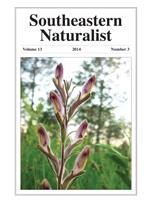Studies of Sciurus niger (Fox Squirrel) in the Southeast have focused on habitat relationships with limited emphasis on other life-history characteristics. We estimated survival rates for 51 radio-collared Scinrns n. niger (Southeastern Fox Squirrel) on Fort Bragg, NC, during March 2011-June 2012 using the Kaplan-Meier staggered-entry design. Also, we calculated composite and seasonal 99% kernel-density home-range estimates for male and female Fox Squirrels. During our study, 22 radio-collared Fox Squirrels died: 8 were depredated, 2 were hunter harvested, and 12 died of unknown causes. Survival rates differed among the seasons when the sexes were combined; survival was greatest in the winter and lowest in the fall. Male annual survival (0.35) was lower than female annual survival (0.66) at the a = 0.10 level. Male home ranges were larger than female home ranges, potentially exposing them to greater predation risk. High mortality of male Fox Squirrels may warrant reevaluation of harvest regulations for declining, hunted Fox Squirrel populations. Additionally, large space requirements for Fox Squirrels may be indicative of low availability of forage on the landscape, a condition that should prompt land managers to adjust management actions to improve habitat conditions for Fox Squirrels.
How to translate text using browser tools
1 January 2014
Survival and Home-Range Size of Southeastern Fox Squirrels in North Carolina
Annemarie Prince,
Christopher S. DePerno,
Beth Gardner,
Christopher E. Moorman
ACCESS THE FULL ARTICLE

Southeastern Naturalist
Vol. 13 • No. 3
September 2014
Vol. 13 • No. 3
September 2014




